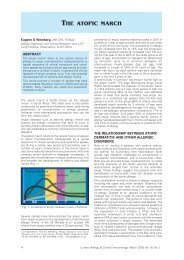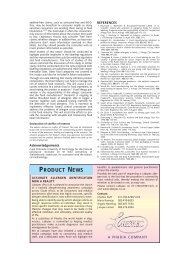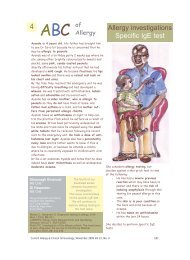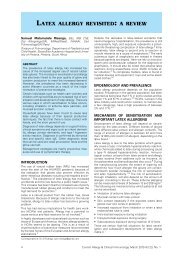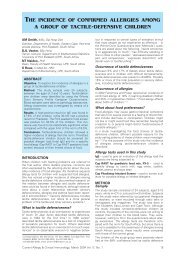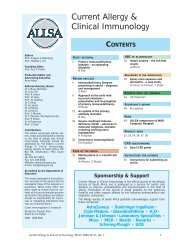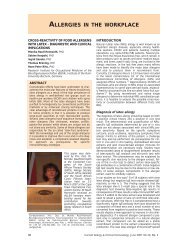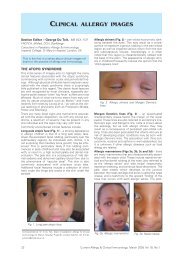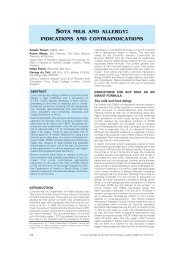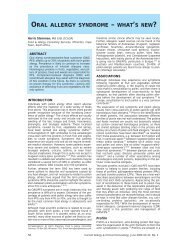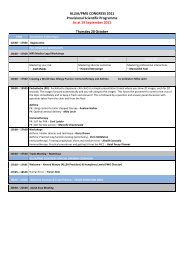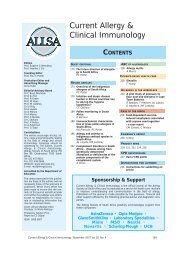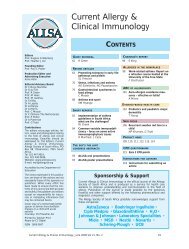Create successful ePaper yourself
Turn your PDF publications into a flip-book with our unique Google optimized e-Paper software.
should be used in order <strong>to</strong> plot growth. Ascertain frequency<br />
of symp<strong>to</strong>ms: recurrent cough, particularly at<br />
night, wheeze, shortness of breath and tight chest. Be<br />
aware of symp<strong>to</strong>ms that are worse or prolonged in the<br />
presence of triggers, and patient his<strong>to</strong>ry (or family his<strong>to</strong>ry)<br />
of eczema, rhinitis, allergies, etc. Exacerbations<br />
– note frequency and duration. Finally, observe for obvious<br />
signs of allergy, eczema, allergic salute.<br />
Conducting lung function tests (LFTs) in<br />
the clinic<br />
Peak expira<strong>to</strong>ry flow. Compare PEF with best personal<br />
or charts of predicted value for age/height (adults) or<br />
height (children) and record. Patient should stand. Take<br />
3 readings, and record the highest of these. Always<br />
demonstrate carefully <strong>to</strong> new patients. The educa<strong>to</strong>r<br />
should be aware of the following: use the same type<br />
of peak flow; under 4 years the readings may not be<br />
accurate. Fac<strong>to</strong>rs which affect PEF include chronic obstructive<br />
pulmonary disease (COPD), technique, time of<br />
day, recent use of bronchodila<strong>to</strong>r, and false teeth. If PEF<br />
is less than expected, give an adequate dose of SAB2,<br />
wait 10 minutes and then redo the LFTs. Work out peak<br />
flow variability. Subtract the lowest reading from the<br />
highest reading, divide by the highest reading, multiply<br />
by 100% and this will then give you the percentage variability.<br />
More than 15% diurnal or variation on bronchodila<strong>to</strong>r<br />
reversibility testing, exercise testing or steroid trial<br />
testing may indicate or confirm asthma.<br />
Flow volume loop, forced expira<strong>to</strong>ry volume after 1<br />
second (FEV 1 ) and forced vital capacity (FVC). These<br />
lung volumes and capacities are measured with spirometers.<br />
Correct blowing technique and evaluation of normal<br />
and abnormal should be carried out. The educa<strong>to</strong>r<br />
should be knowledable regarding normal and abnormal<br />
curves (possibly due <strong>to</strong> insufficient cooperation as opposed<br />
<strong>to</strong> irritable airways). Most modern LF equipment<br />
will show pre- and post-bronchodilation, with percentages,<br />
readily and easily. Print and attach for doc<strong>to</strong>r in<br />
the folder.<br />
It is a good idea <strong>to</strong> encourage patients <strong>to</strong> bring their devices<br />
(including spacers) <strong>to</strong> the clinic visit every time.<br />
After the doc<strong>to</strong>r has seen the patient and taken a full<br />
detailed his<strong>to</strong>ry (current and past medical, asthma,<br />
smoking his<strong>to</strong>ry, occupation, previous and current asthma<br />
medication, over-the-counter meds, etc), the nurse<br />
might be asked <strong>to</strong> conduct or explain one of the following<br />
tests <strong>to</strong> the patient, in order <strong>to</strong> confirm his/her<br />
suspicions of asthma, in spite of normal LFTs.<br />
Use of diary cards<br />
Keeping and recording peak flow at home for 2 weeks.<br />
Give a patient a peak flow meter and peak flow diary<br />
chart, so that they can record their peak flow. Advise<br />
patient <strong>to</strong> carry out PEF at the same time of day, every<br />
morning and every night, prior <strong>to</strong> medication, and<br />
<strong>to</strong> record treatment (inhaled corticosteroid, SAB2 and<br />
long-acting β 2 -agonists), and <strong>to</strong> administer SAB2 when<br />
necessary. Patient should record pre and post values.<br />
When patients return for a follow-up appointment, the<br />
educa<strong>to</strong>r will calculate the PEF variability and be aware<br />
that a greater than 15% diurnal variation indicates<br />
asthma (very often an early morning dip), and that a<br />
stable PEF recording within normal range indicates that<br />
asthma (if present) is well controlled. Patients should<br />
be encouraged never <strong>to</strong> s<strong>to</strong>p medication until they have<br />
seen the doc<strong>to</strong>r.<br />
Conducting an exercise test<br />
Measure peak flow (highest of 3 readings). Patient then<br />
takes vigorous continuous exercise for 6 minutes, repeat<br />
the PEF immediately, and repeat at 5-minute intervals<br />
for 15 minutes. A fall of 15% or more is positive.<br />
Administer SAB2 if necessary. Always bear in mind that<br />
the greater the variability, the more hyperresponsive<br />
the airways.<br />
Skin-prick tests<br />
Having taken a good his<strong>to</strong>ry, the doc<strong>to</strong>r will identify<br />
which allergens he/she wishes <strong>to</strong> be tested. The patient<br />
must not have taken any antihistamines for the<br />
previous 72 hours. If excema is widespead on the arms,<br />
the back may be used. A full and comprehensive explanation<br />
can be found in the <strong>ALLSA</strong> Handbook. 4 Patients<br />
need <strong>to</strong> give consent (sign and date the form), and the<br />
person performing the skin-prick test must sign as well.<br />
Be aware of derma<strong>to</strong>graphism and pseudopodia and record<br />
them in the notes. Blood tests may be ordered.<br />
Education and treating specific allergies<br />
Identify the allergens and proceed with allergen avoidance<br />
information. Provide patient with information<br />
sheets. Should any his<strong>to</strong>ry prove that a trigger is potentially<br />
life-threatening, discuss the need for a Medic Alert<br />
bracelet. A clearly marked action form should state what<br />
<strong>to</strong> do and when. In a mild reaction antihistamines may<br />
suffice, but if there are any respira<strong>to</strong>ry symp<strong>to</strong>ms, then<br />
4 puffs of SAB2 should be administered. Should the reaction<br />
be major with breathing difficulties or change in<br />
consciousness, then adrenaline should be given intramuscularly.<br />
A small pack should be given <strong>to</strong> take home,<br />
with either a vial of adrenaline (check expiry date), or<br />
Epipen, with instructions on how <strong>to</strong> give the adrenaline.<br />
The usual dose for an adult is 0.5 ml intramuscularly and<br />
for a child over 3 years 0.3 ml intramuscularly immediately.<br />
The injection must be repeated if no response<br />
in 5 minutes and the patient must be brought <strong>to</strong> the<br />
emergency room.<br />
Most common inhalant allergens tested are: house-dust<br />
mite (HDM), grass, moulds, dog, cat, tree – seasonal<br />
changes will determine further requests. Skin-prick<br />
tests are also available for a range of food allergens and<br />
their negative predicted value is very good.<br />
Practical tips on how <strong>to</strong> avoid HDMs (the most common<br />
allergen). While this can be time-consuming, it is<br />
of vital importance, because <strong>to</strong>gether with appropriate<br />
pharmacotherapy, you can improve the control of a patient<br />
with asthma. Mattress, duvet and pillow cases<br />
should be encased in high-quality, mite-impermeable<br />
covers. Hot water (>60°C) is effective in killing HDM.<br />
Rooms should not be vacuumed while the patient is in<br />
the room, and soft <strong>to</strong>ys should be placed in the freezer<br />
overnight once a month.<br />
Treating concomitant rhinitis. Unless the often concomitant<br />
allergic rhinitis is treated, asthma can remain<br />
uncontrolled in spite of optimal treatment. Rhinitis education<br />
should include: using the nasal spray as often<br />
as prescribed by the doc<strong>to</strong>r. There may well not be an<br />
apparent immediate effect, but continuous use is essential.<br />
Blow the nose gently (most rhinitis sufferers<br />
will be more prone <strong>to</strong> nose bleeds than the general<br />
population). These patients will also have more mucus<br />
and sneezing than others. Shake the medicine, and<br />
then insert in<strong>to</strong> the nose, turning the end of the canister<br />
on the right side in the direction <strong>to</strong>wards the right ear<br />
and left <strong>to</strong>wards the left ear. Try not <strong>to</strong> blow the nose<br />
for some time thereafter. Depending on the severity of<br />
the symp<strong>to</strong>ms, drug therapy will involve antihistamine<br />
tablets and/or nasal corticosteroids. In cases of severe<br />
seasonal allergic rhinitis <strong>to</strong> grass and other mono-allergens,<br />
allergen injection or sublingual administration of<br />
immunotherapy may be used. This can be effective and<br />
needs adherence for 3 years, so the doc<strong>to</strong>r needs <strong>to</strong><br />
identify appropriate patients.<br />
Current Allergy & Clinical Immunology, August 2011 Vol 24, No.3 141



